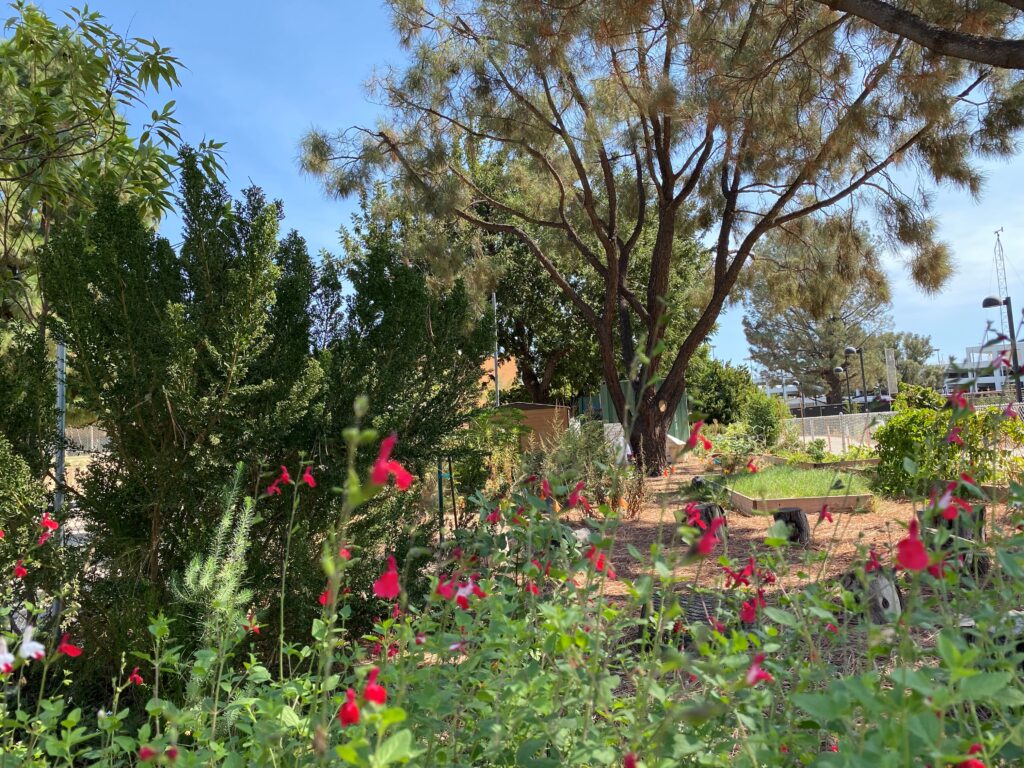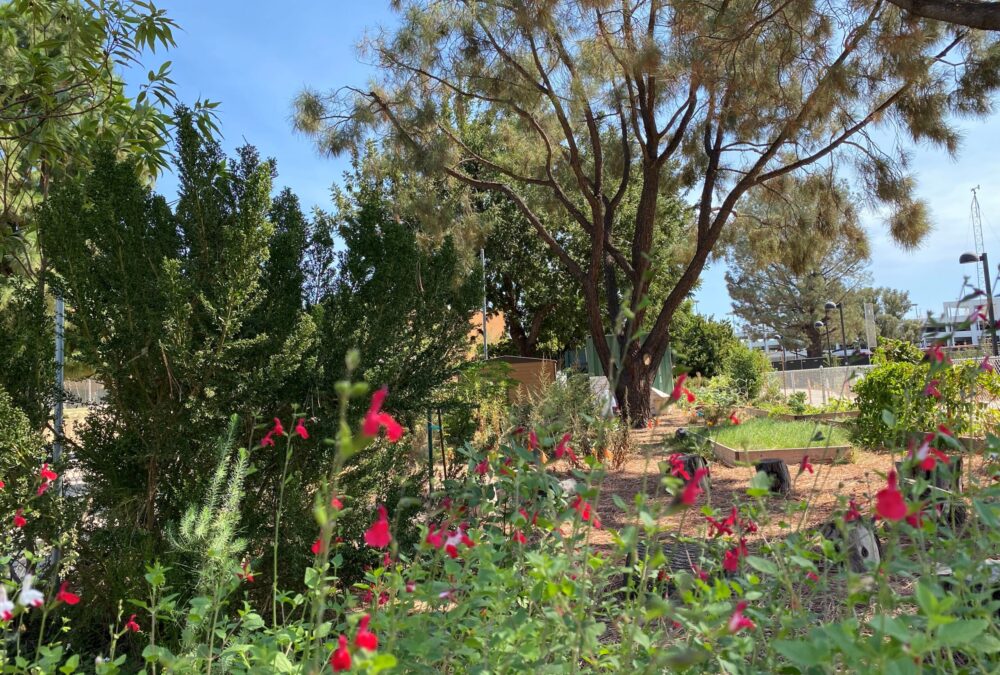
The large oval leaves of a strong, healthy cherimoya tree move with the midday breeze, offering intermittent sunlight to low sprawling mint. Rows of squash, tomatoes, and blossoming basil occupy sunny garden plots along with sage, California buckwheat, and native mugwort. A mature mulberry tree and a fruiting fig stand alongside a small enclosure for starter seedlings and cuttings ready for propagation. Fiery, apricot-colored, desert globe mallow, red and white dancing-lights salvia, and the vital narrow leaf milkweed draw birds and butterflies to the heart of the San Fernando Valley, amidst a small orchard of avocado, plum, and coffee trees.
This Eden is emerging in earnest at California State University, Northridge. The half-acre, sustainable, organic garden is providing hundreds of pounds of fresh produce to the CSUN food pantry, which serves the surprisingly large number of students and some faculty that are food insecure. The garden has 50 fruit trees and 25 coffee trees, interspersed with seasonal vegetables. Two hundred drought-tolerant, native plants are used as cover crops, increasing urban biodiversity while nourishing essential pollinators. This high-density agroforestry helps to retain moisture, creating a microclimate that is more resilient in the California heat.
The Institute of Sustainability and its organic food garden at CSUN started in 2009 and has made CSUN the top California State University for sustainability. CSUN’s Sustainability Center is a Platinum LEED certified building, which demonstrates the university’s commitment to leading the way to a more sustainable future. Dr. Nat Zappia is the Sustainability Director, as well as Associate Professor in CSUN’s history department. While he has a background in urban gardening, as an historian, he recognizes the power of story to move people and shift culture. The intersection of sustainability and social justice issues drives his passion about food equity and community-based entrepreneurial projects.
Zappia strives to provide hands-on experience and knowledge to his students for emerging career pathways while staying the course of CSUN’s commitment to be zero waste by 2025. Zappia says, “We need to rethink food production sites to recognize that everything, even so-called garden pests, have a purpose. People get frustrated by gophers, but they help aerate and mulch the soil.”
Zappia hopes that the university will expand its garden efforts to include some of the five acres of old-growth citrus orchards on campus, some of the last acres of orange trees that once covered the San Fernando Valley.
“We need to protect the past, while looking toward the future,” he says. Zappia sees the potential to improve the approximately 400-tree monocrop orchard by adding native plant cover crops in the shade of the trees. CSUN is preserving the orange groves as an important piece of California’s history and shares the bounty with their food pantry, many non profits, as well as anyone in the community that would like to pick oranges.
The university has made efforts to publicly acknowledge the native people of the land it occupies and works in partnership with the Tataviam people, whose ancestral land includes northwest present-day Los Angeles County. Indigenous land practices are recognized and utilized in the garden, while being integrated with some newer technologies.
All green waste from the 5,000 campus trees is kept on campus and recycled into mulch and compost. The success of student involvement in campus-wide, food scrap composting has created the opportunity to expand and explore new technologies. CSUN is currently preparing to host a large-scale bio-digester system, which creates a concentrated, dry compost and may venture into vermicomposting in the future. The university’s Institute of Sustainability is excited to have just launched its sustainable fashion program and will be growing additional plants from which to create natural dyes. CSUN will soon welcome a freight farm on campus as well: a 10 x 40 shipping container that can grow the equivalent of 2 acres of food.
Surrounded by school tennis courts and baseball and soccer fields, the food garden used to be an empty plot of dry dirt. It took years to rebuild the soil with compost, mulch, and many green thumbs. The garden’s success is a reminder of the promise that every piece of earth holds to be reborn with some love, hard work, and a respect for natural systems. CSUN is leading the way to a greener, more resilient future by nurturing stewards of the earth that have experience in sustainability, social responsibility, and soil regeneration.













